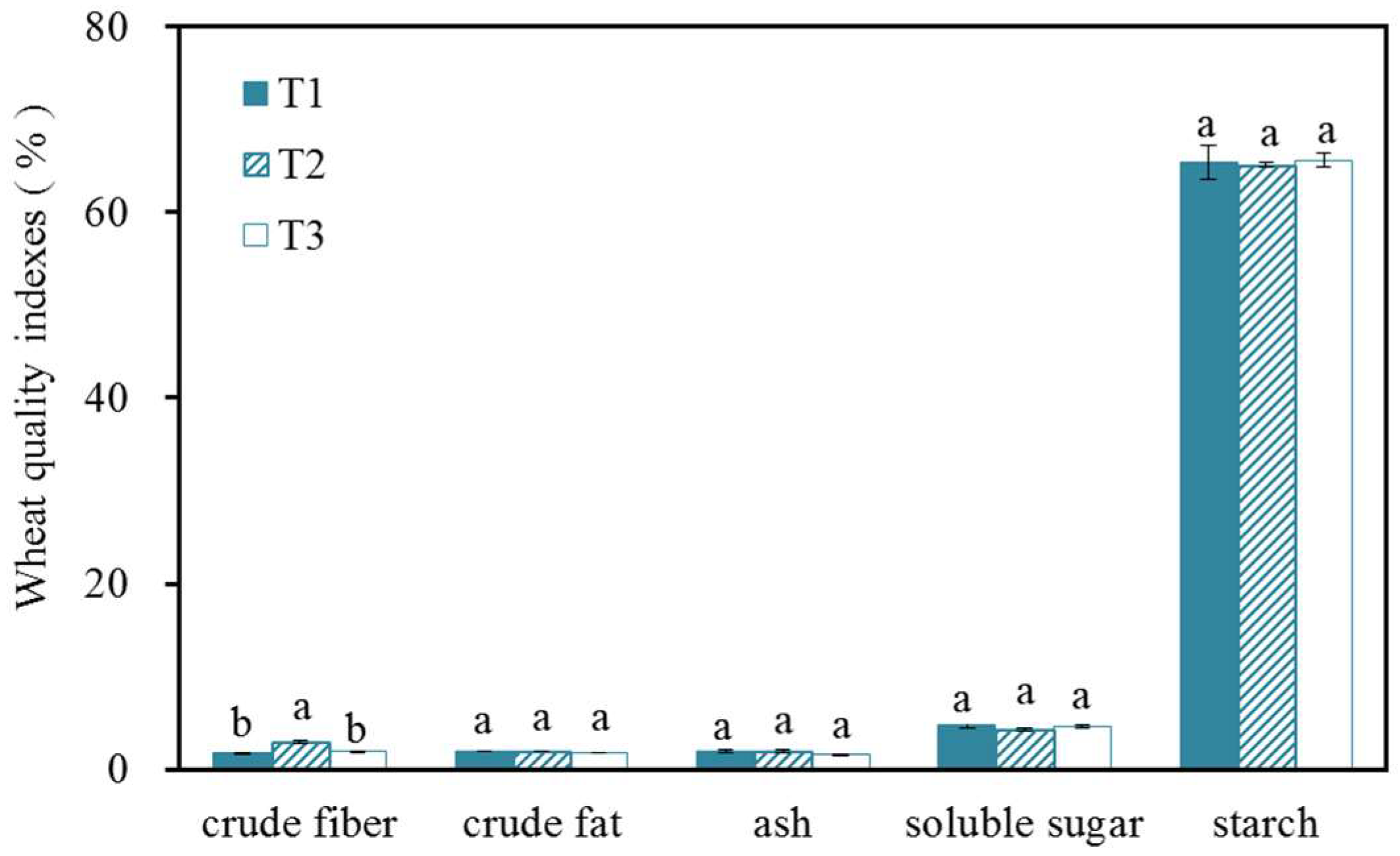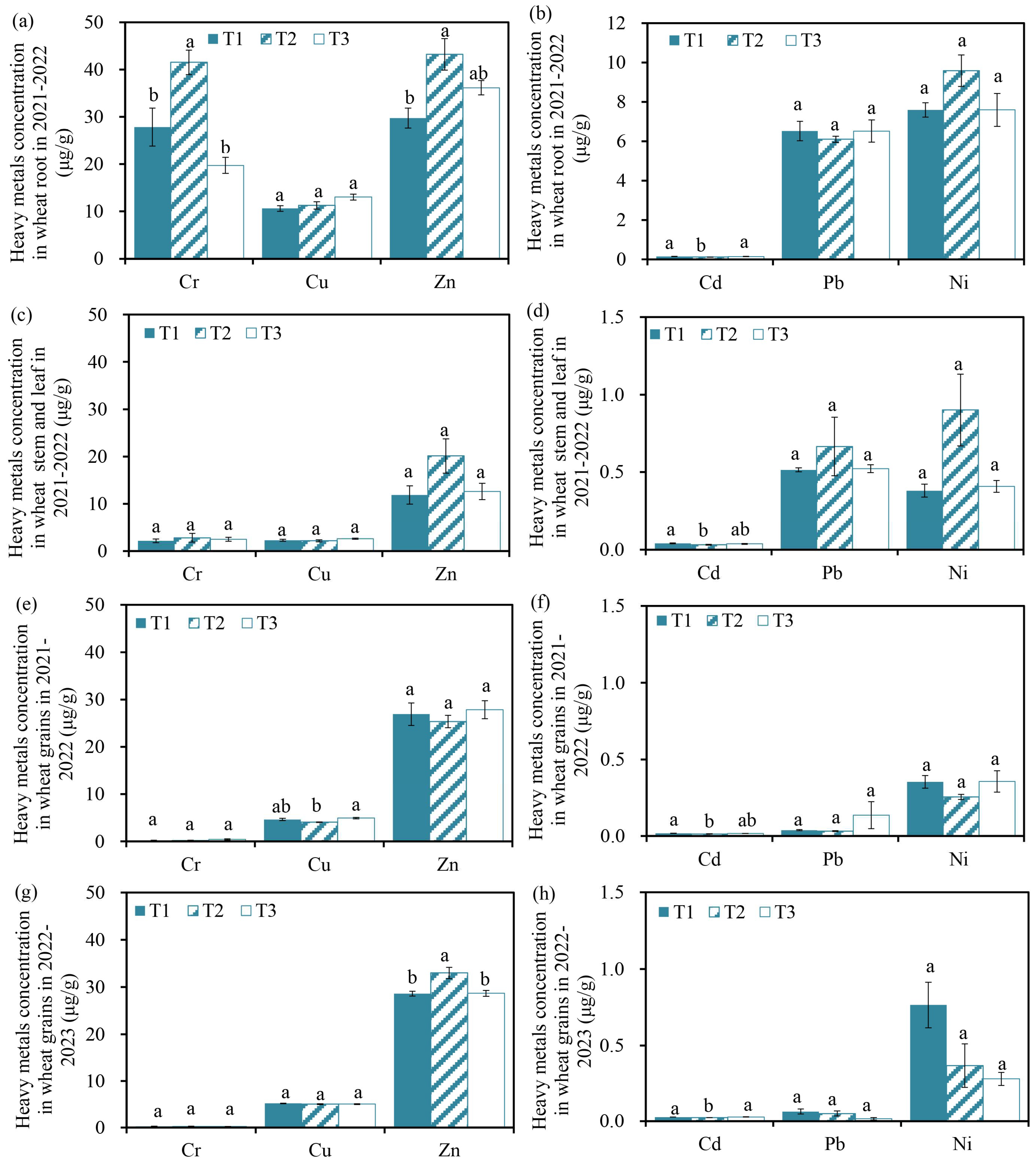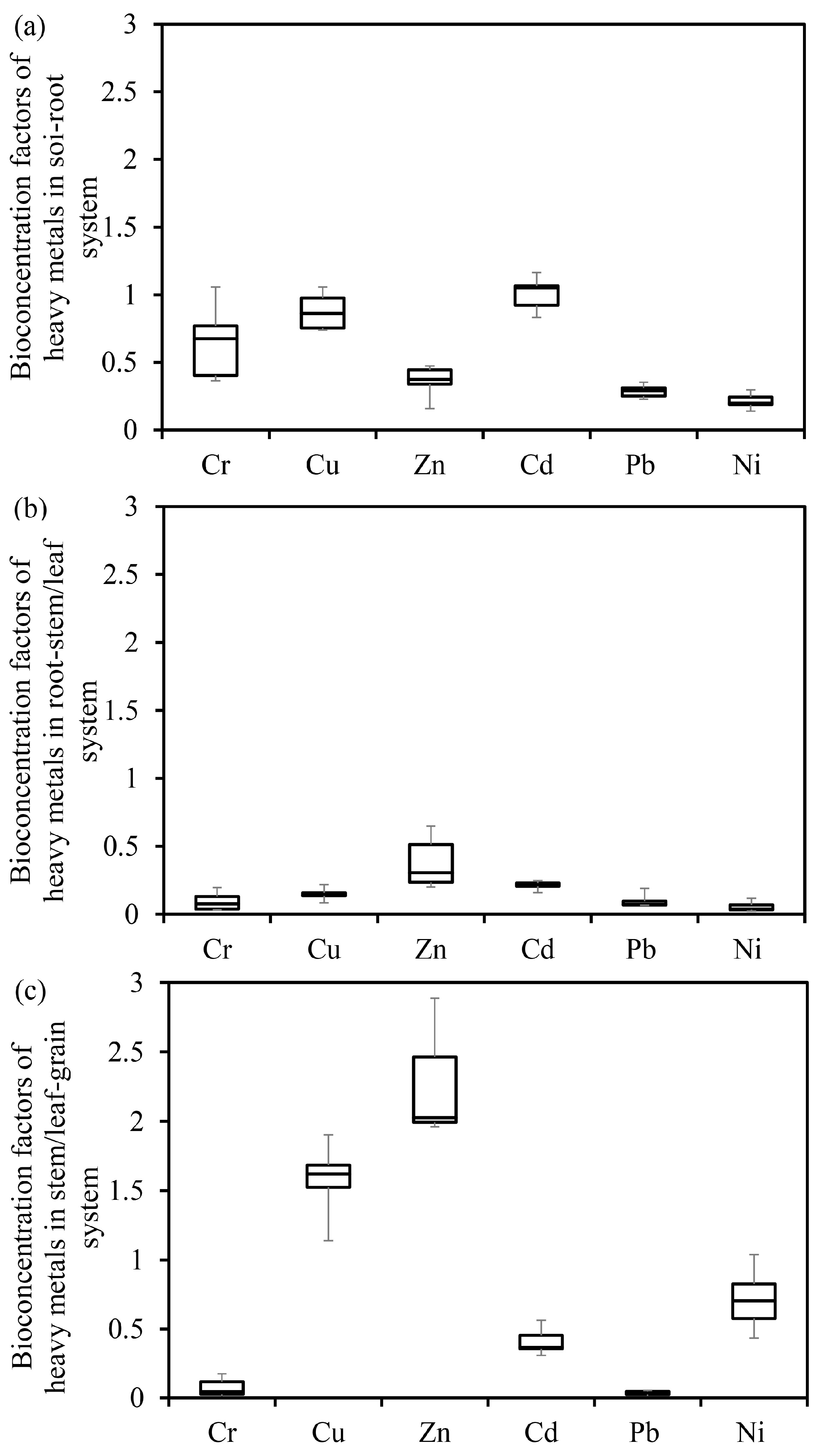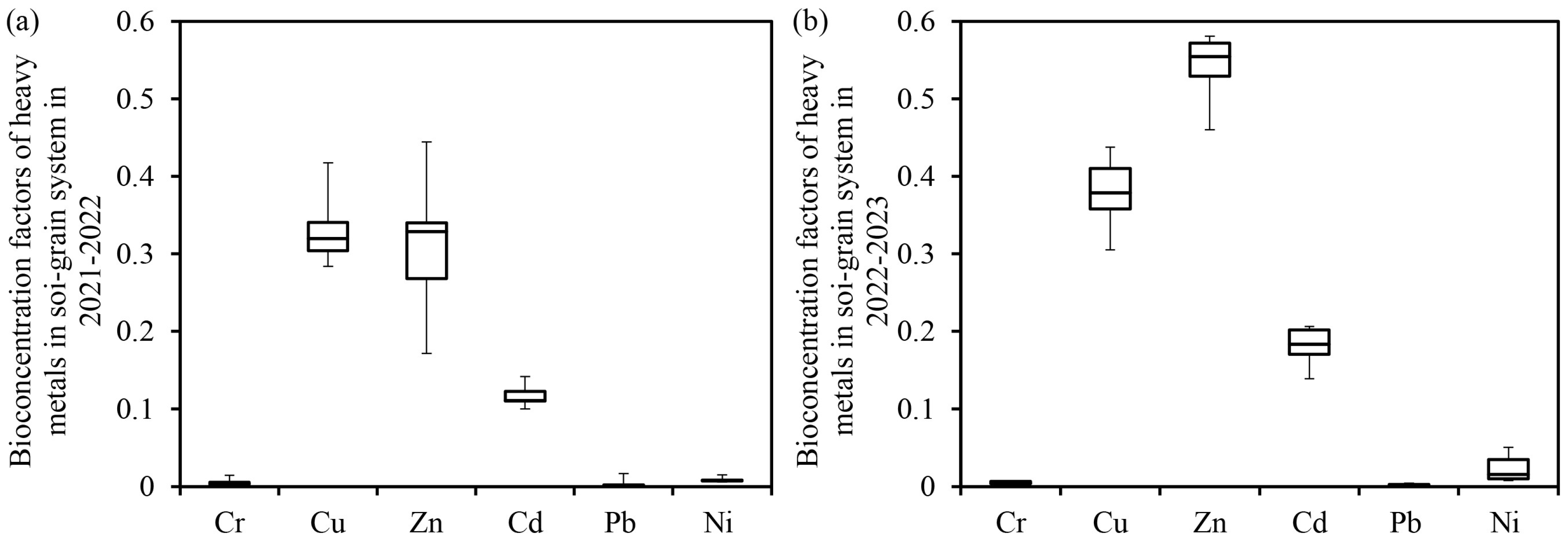Effects of Organic Manure on Wheat Yield and Accumulation of Heavy Metals in a Soil—Wheat System
Abstract
1. Introduction
2. Materials and Methods
2.1. Site Information and Experimental Design
2.2. Experimental Observations and Methods
- (1)
- Determination of winter wheat grain yield
- (2)
- Determination of heavy metals in soil and winter wheat
- (3)
- Determination of winter grain quality
2.3. Data Calculation and Analysis
- (1)
- Calculation of the bioconcentration factors (BCFs)
- (2)
- Data analysis
3. Results
3.1. Wheat Grain Yields and Yield Components in Different Fertilizer Treatments
3.2. Heavy Metals’ Concentrations in Topsoil in Different Fertilizer Treatments
3.3. Heavy Metals’ Concentrations in Different Parts of Winter Wheat in Different Fertilizer Treatments
3.4. Heavy Metals’ Bioconcentration Factors in the Soil–Winter Wheat System in Different Fertilizer Treatments
4. Discussion
4.1. Effects of Different Fertilizer Treatments on Wheat Grain Yields and Wheat Grain Qualities
4.2. Effects of Different Fertilizer Treatments on Heavy Metals Concentrations in Topsoil
4.3. Effects of Different Fertilizer Treatments on the Migration of Heavy Metals in Soil–Winter Wheat System
5. Conclusions
Author Contributions
Funding
Data Availability Statement
Acknowledgments
Conflicts of Interest
References
- Zhang, Y.S.; Fan, X.L.; Mao, Y.; Wei, Y.J.; Xu, J.M.; Wu, L.L. The Coupling Relationship and Driving Factors of Fertilizer Consumption, Economic Development and Crop Yield in China. Sustainability 2023, 15, 7851. [Google Scholar] [CrossRef]
- Misselbrook, T.H.; Bai, Z.; Cai, Z.; Cao, W.; Carswell, A.; Cowan, N.J.; Cui, Z.; Chadwick, D.; Emmett, B.A.; Goulding, K.W.; et al. Progress on improving agricultural nitrogen use efficiency: UK-China virtual joint centers on nitrogen agronomy. Front. Agric. Sci. Eng. 2022, 9, 475–489. [Google Scholar]
- Ranjan, R.; Yadav, R. Targeting nitrogen use efficiency for sustained production of cereal crops. J. Plant Nutr. 2019, 42, 1086–1113. [Google Scholar] [CrossRef]
- Wang, R.N.; Sun, C.H.; Cai, S.; Liu, F.P.; Xie, H.W.; Xiong, Q.Q. Research Progress in Crop Root Biology and Nitrogen Uptake and Use, with Emphasis on Cereal Crops. Agronomy 2023, 13, 1678. [Google Scholar] [CrossRef]
- Tian, M.L.; Liu, R.F.; Wang, J.; Liang, J.H.; Nian, Y.F.; Ma, H.Y. Impact of Environmental Values and Information Awareness on the Adoption of Soil Testing and Formula Fertilization Technology by Farmers-A Case Study Considering Social Networks. Agriculture 2023, 13, 2008. [Google Scholar] [CrossRef]
- Shen, C.; He, M.Y.; Zhang, J.H.; Liu, J.L.; Wang, Y.D. Response of soil antibiotic resistance genes and bacterial communities to fresh cattle manure and organic fertilizer application. J. Environ. Manag. 2024, 349, 119453. [Google Scholar] [CrossRef]
- Song, K.; Xue, Y.; Zheng, X.Q.; Lv, W.G.; Qiao, H.X.; Qin, Q.; Yang, J.J. Effects of the continuous use of organic manure and chemical fertilizer on soil inorganic phosphorus fractions in calcareous soil. Sci. Rep. 2017, 7, 1164. [Google Scholar] [CrossRef]
- Haque, M.M.; Biswas, J.C.; Islam, M.R.; Islam, A.; Kabir, M.S. Effect of long-term chemical and organic fertilization on rice productivity, nutrient use-efficiency, and balance under a rice-fallow-rice system. J. Plant Nutr. 2019, 42, 2901–2914. [Google Scholar] [CrossRef]
- He, D.; Wei, X.; Lin, Z.; Guo, W.; Chen, Z.; Chen, R.; Chen, X.; Xie, X.; Liu, H. Effects of different organic fertilizers on fungal community structure and functional groups in red soil with tobacco plantation. J. Plant Nutr. Fertil. 2020, 26, 2081–2094. [Google Scholar]
- Wang, H.Q.; Zhang, L. The effect of environmental cognition on farmers’ use behavior of organic fertilizer. Environ. Dev. Sustain. 2023, 1–21. [Google Scholar] [CrossRef]
- Zheng, E.N.; Zhu, Y.H.; Qin, M.T.; Chen, P.; Liu, M.; Qi, Z.J. Effects of Organic Fertilizer Replacement Nitrogen Fertilizer on Nitrogen Utilization and Growth of Mung Bean: Evidence from 5N-Tracing Technology. Agronomy 2023, 13, 235. [Google Scholar] [CrossRef]
- Xu, Y.; Li, J.; Zhang, X.B.; Wang, L.Q.; Xu, X.B.; Xu, L.; Gong, H.R.; Xie, H.Y.; Li, F.D. Data integration analysis: Heavy metal pollution in China’s large-scale cattle rearing and reduction potential in manure utilization. J. Clean Prod. 2019, 232, 308–317. [Google Scholar] [CrossRef]
- Gruznova, K.A.; Bashmakov, D.I.; Miliauskiene, J.; Vastakaite, V.; Duchovskis, P.; Lukatkin, A.S. The effect of a growth regulator Ribav-Extra on winter wheat seedlings exposed to heavy metals. Zemdirbyste 2018, 105, 227–234. [Google Scholar] [CrossRef]
- Qian, X.Y.; Wang, Z.Q.; Shen, G.X.; Chen, X.H.; Tang, Z.Z.; Guo, C.X.; Gu, H.R.; Fu, K. Heavy metals accumulation in soil after 4 years of continuous land application of swine manure: A field-scale monitoring and modeling estimation. Chemosphere 2018, 210, 1029–1034. [Google Scholar] [CrossRef] [PubMed]
- Zhen, H.Y.; Jia, L.; Huang, C.D.; Qiao, Y.H.; Li, J.; Li, H.F.; Chen, Q.; Wan, Y.A. Long-term effects of intensive application of manure on heavy metal pollution risk in protected-field vegetable production. Environ. Pollut. 2020, 263, 114552. [Google Scholar] [CrossRef]
- Ugulu, I.; Ahmad, K.; Khan, Z.I.; Munir, M.; Wajid, K.; Bashir, H. Effects of organic and chemical fertilizers on the growth, heavy metal/metalloid accumulation, and human health risk of wheat (Triticum aestivum L.). Environ. Sci. Pollut. Res. 2021, 28, 12533–12545. [Google Scholar] [CrossRef]
- Hussain, B.; Li, J.M.; Ma, Y.B.; Chen, Y.; Wu, C.Y.; Ullah, A.; Tahir, N. A Field Evidence of Cd, Zn and Cu Accumulation in Soil and Rice Grains after Long-Term (27 Years) Application of Swine and Green Manures in a Paddy Soil. Sustainability 2021, 13, 2404. [Google Scholar] [CrossRef]
- Zhang, G.B.; Song, K.F.; Huang, Q.; Zhu, X.L.; Gong, H.; Ma, J.; Xu, H. Heavy metal pollution and net greenhouse gas emissions in a rice-wheat rotation system as influenced by partial organic substitution. J. Environ. Manag. 2022, 307, 114599. [Google Scholar] [CrossRef]
- Bridhikitti, A.; Kaewsuk, J.; Karaket, N.; Somchat, K.; Friend, R.; Sallach, B.; Chong, J.P.J.; Redeker, K.R. Sources and Magnitude of Heavy Metals in Sugarcane Plantation Soils with Different Agricultural Practices and Their Implications on Sustainable Waste-to-Foods Strategy in the Sugar-Ethanol Industry. Sustainability 2023, 15, 14816. [Google Scholar] [CrossRef]
- Xiang, M.T.; Ma, J.Y.; Cheng, J.L.; Lei, K.G.; Li, F.; Shi, Z.; Li, Y. Collaborative evaluation of heavy metal pollution of soil-crop system in the southeast of Yangtze River Delta, China. Ecol. Indic. 2022, 143, 109412. [Google Scholar] [CrossRef]
- Ahmad, K.; Wajid, K.; Khan, Z.I.; Ugulu, I.; Memoona, H.; Sana, M.; Nawaz, K.; Malik, I.S.; Bashir, H.; Sher, M. Evaluation of Potential Toxic Metals Accumulation in Wheat Irrigated with Wastewater. Bull. Environ. Contam. Toxicol. 2019, 102, 822–828. [Google Scholar] [CrossRef] [PubMed]
- Mehmood, A.; Mirza, M.A.; Choudhary, M.A.; Kim, K.H.; Raza, W.; Raza, N.; Lee, S.S.; Zhang, M.; Lee, J.H.; Sarfraz, M. Spatial distribution of heavy metals in crops in a wastewater irrigated zone and health risk assessment. Environ. Res. 2019, 168, 382–388. [Google Scholar] [CrossRef] [PubMed]
- Sharma, S.; Nagpal, A.K.; Kaur, I. Heavy metal contamination in soil, food crops and associated health risks for residents of Ropar wetland, Punjab, India and its environs. Food Chem. 2018, 255, 15–22. [Google Scholar] [CrossRef] [PubMed]
- GB 5009.6-2016; National Food Safety Standard Determination of Fat in Food. National Health and Family Planning Commission of the People’s Republic of China, State Food and Drug Administration: Beijing, China, 2016.
- AOAC. Official Methods of Analysis American Assoc. of Official Analytical Chemists. 2019. Available online: https://www.aoac.org/ (accessed on 10 August 2024).
- Dien, D.C.; Mochizuki, T.; Yamakawa, T. Effect of various drought stresses and subsequent recovery on proline, total soluble sugar and starch metabolisms in Rice (Oryza sativa L.) varieties. Plant. Prod. Sci. 2019, 22, 530–545. [Google Scholar] [CrossRef]
- Cisse, A.; Arshad, A.; Wang, X.F.; Yattara, F.; Hu, Y.G. Contrasting Impacts of Long-Term Application of Biofertilizers and Organic Manure on Grain Yield of Winter Wheat in North China Plain. Agronomy 2019, 9, 312. [Google Scholar] [CrossRef]
- GB15618-2018; Soil Environmental Quality-Risk Control Standards for Soil Contamination of Agricultural Land. Ministry of Ecology and Environment of the PRC: Beijing, China, 2018.
- NY861-2004; Limits of Eight Elements in Cereals, Legume, Tubes, and Its Products. Agricultural Ministry of the People’s Republic of China: Beijing, China, 2004.
- Ugulu, I.; Akhter, P.; Khan, Z.I.; Akhtar, M.; Ahmad, K. Trace metal accumulation in pepper (Capsicum annuum L.) grown using organic fertilizers and health risk assessment from consumption. Food Res. Int. 2021, 140, 109992. [Google Scholar] [CrossRef]
- He, H.; Zhang, Y.T.; Wei, C.Z.; Li, J.H. Characteristics of Decomposition and Nutrient Release of Corn Straw Under Different Organic Fertilizer Replacement Rates. Appl. Ecol. Environ. Res. 2019, 17, 13455–13472. [Google Scholar] [CrossRef]
- Han, X.M.; Hu, C.; Chen, Y.F.; Qiao, Y.; Liu, D.H.; Fan, J.; Li, S.L.; Zhang, Z. Crop yield stability and sustainability in a rice-wheat cropping system based on 34-year field experiment. Eur. J. Agron. 2020, 113, 125965. [Google Scholar] [CrossRef]
- Khanghahi, M.Y.; AbdElgawad, H.; Verbruggen, E.; Korany, S.M.; Alsherif, E.A.; Beemster, G.T.S.; Crecchio, C. Biofertilisation with a consortium of growth-promoting bacterial strains improves the nutritional status of wheat grain under control, drought, and salinity stress conditions. Physiol. Plant. 2022, 174, e13800. [Google Scholar]
- Litoriya, N.S.; Modi, A.R.; Talati, J.G. Nutritional Evaluation of Durum Wheat with Respect to Organic and Chemical Fertilizers. Agric. Res. 2018, 7, 152–157. [Google Scholar] [CrossRef]
- Zhu, Y.; An, Y.F.; Li, X.Y.; Cheng, L.; Lv, S.J. Geochemical characteristics and health risks of heavy metals in agricultural soils and crops from a coal mining area in Anhui province, China. Environ. Res. 2024, 241, 117670. [Google Scholar] [CrossRef] [PubMed]
- Liu, Y.; He, G.D.; He, T.B.; Saleem, M. Signaling and Detoxification Strategies in Plant-Microbes Symbiosis under Heavy Metal Stress: A Mechanistic Understanding. Microorganisms 2023, 11, 69. [Google Scholar] [CrossRef] [PubMed]
- Aprile, A.; Sabella, E.; Francia, E.; Milc, J.; Ronga, D.; Pecchioni, N.; Ferrari, E.; Luvisi, A.; Vergine, M.; De Bellis, L. Combined Effect of Cadmium and Lead on Durum Wheat. Int. J. Mol. Sci. 2019, 20, 5891. [Google Scholar] [CrossRef] [PubMed]
- Li, X.X.; Lan, X.; Liu, W.; Cui, X.W.; Cui, Z.J. Toxicity, migration and transformation characteristics of lead in soil-plant system: Effect of lead species. J. Hazard. Mater. 2020, 395, 122676. [Google Scholar] [CrossRef]
- Wang, S.Y.; Wu, W.Y.; Liu, F.; Liao, R.K.; Hu, Y.Q. Accumulation of heavy metals in soil-crop systems: A review for wheat and corn. Environ. Sci. Pollut. Res. 2017, 24, 15209–15225. [Google Scholar] [CrossRef]
- Ejaz, A.; Khan, Z.I.; Ahmad, K.; Muhammad, F.G.; Akhtar, S.; Hussain, M.I. Appraising growth, daily intake, health risk index, and pollution load of Zn in wheat (Triticum aestivum L.) grown in soil differentially spiked with zinc. Environ. Sci. Pollut. Res. 2022, 29, 34685–34700. [Google Scholar] [CrossRef]
- Krishna, T.P.A.; Maharajan, T.; Roch, G.V.; Ignacimuthu, S.; Ceasar, S.A. Structure, Function, Regulation and Phylogenetic Relationship of ZIP Family Transporters of Plants. Front. Plant Sci. 2020, 11, 662. [Google Scholar]
- Krishna, T.P.A.; Maharajan, T.; Ceasar, S.A. The Role of Membrane Transporters in the Biofortification of Zinc and Iron in Plants. Biol. Trace Elem. Res. 2023, 201, 464–478. [Google Scholar] [CrossRef]
- Lan, W.C.; Yao, C.X.; Luo, F.; Jin, Z.; Lu, S.W.; Li, J.; Wang, X.D.; Hu, X.F. Effects of Application of Pig Manure on the Accumulation of Heavy Metals in Rice. Plants 2022, 11, 207. [Google Scholar] [CrossRef]
- Kuziemska, B.; Wysokinski, A.; Klej, P. The Content, Uptake and Bioaccumulation Factor of Copper and Nickel in Grass Depending on Zinc Application and Organic Fertilization. Agriculture 2023, 13, 1676. [Google Scholar] [CrossRef]
- Zhou, J.; Zhang, C.; Du, B.Y.; Cui, H.B.; Fan, X.J.; Zhou, D.M.; Zhou, J. Effects of zinc application on cadmium (Cd) accumulation and plant growth through modulation of the antioxidant system and translocation of Cd in low- and high-Cd wheat cultivars. Environ. Pollut. 2020, 265, 115045. [Google Scholar] [CrossRef] [PubMed]
- Zhang, Y.; Yin, C.B.; Cao, S.Z.; Cheng, L.L.; Wu, G.S.; Guo, J.B. Heavy metal accumulation and health risk assessment in soil-wheat system under different nitrogen levels. Sci. Total Environ. 2018, 622, 1499–1508. [Google Scholar] [CrossRef] [PubMed]
- Dong, H.Z.; Gao, Z.J.; Liu, J.T.; Jiang, B. Study on the Accumulation of Heavy Metals in Different Soil-Crop Systems and Ecological Risk Assessment: A Case Study of Jiao River Basin. Agronomy 2023, 13, 2238. [Google Scholar] [CrossRef]





| Soil Depth (cm) | Volumetric Weight (g/cm3) | Saturated Water Content (%) | Field Capacity (%) | Soil Texture (International) |
|---|---|---|---|---|
| 0–20 | 1.41 | 0.44 | 0.37 | loam |
| 20–40 | 1.36 | 0.35 | 0.29 | sandy loam |
| 40–60 | 1.54 | 0.40 | 0.34 | sandy loam |
| 60–80 | 1.40 | 0.44 | 0.37 | silty loam |
| 80–100 | 1.47 | 0.45 | 0.38 | silty loam |
| Various Substances | N | P | K | Cu | Pb | Zn | Cr | Ni | Cd |
|---|---|---|---|---|---|---|---|---|---|
| Organic cattle manure | 21,500 | 23,500 | 28,900 | 25.9 | 6.0 | 103 | 7.0 | 12.1 | ND |
| Organic pig manure | 24,600 | 22,600 | 28,400 | 155 | 6.0 | 240 | 16.8 | 13.7 | ND |
| topsoil | 710 | 530 | 5120 | 14.8 | 47.9 | 38.7 | 58.7 | 19.7 | 0.86 |
| Treatments | Base Fertilizer | Topdressing (Urea) | ||
|---|---|---|---|---|
| N/P/K | Fertilizer Type | N at Tillering Stage | N at Jointing Stage | |
| T1 | 120/130/160 | organic cattle manure (8.45 t/ha) | 60 | 60 |
| T2 | 120/130/160 | organic pig manure (8.55 t/ha) | 60 | 60 |
| T3 | 120/130/160 | Urea, KH2PO4 (0.26 t/ha, 0.57 t/ha) | 60 | 60 |
| Year | Treatments | Yield (t/ha) | Spike Length (cm) | Spike Number (per Plant) | Grain Number (per Spike) | 1000-Grain Weight (g) |
|---|---|---|---|---|---|---|
| 2021–2022 | T1 | 3.87 ± 0.61 a | 6.50 ± 0.37 b | 14.5 ± 0.82 b | 19.2 ± 3.30 b | 53.3 ± 1.25 a |
| T2 | 4.68 ± 0.28 a | 6.61 ± 0.41 b | 15.3 ± 1.00 b | 20.3 ± 2.59 b | 55.6 ± 1.27 a | |
| T3 | 6.24 ± 1.07 a | 7.83 ± 0.30 a | 18.2 ± 0.86 a | 31.8 ± 4.93 a | 55.6 ± 0.25 a | |
| 2022–2023 | T1 | 5.69 ± 0.77 a | 7.50 ± 0.39 a | 16.0 ± 0.87 b | 33.6 ± 3.39 ab | 54.7 ± 0.97 a |
| T2 | 5.22 ± 0.84 a | 6.97 ± 0.28 b | 16.2 ± 0.81 b | 30.6 ± 3.22 b | 55.9 ± 0.90 a | |
| T3 | 5.84 ± 0.67 a | 7.59 ± 0.42 a | 17.3 ± 0.84 a | 35.0 ± 4.93 a | 53.3 ± 1.80 a | |
| Year | ns | * | ns | * | ns | |
| Treatment | ns | * | * | * | ns | |
| Year × Treatment | ns | * | * | * | ns | |
| Year | Treatment | Cr | Cu | Zn | Cd | Pb | Ni |
|---|---|---|---|---|---|---|---|
| 2021–2022 | T1 | 43.54 ± 0.76 a | 13.37 ± 0.20 a | 65.74 ± 4.31 a | 0.14 ± 0.01 a | 21.93 ± 0.37 a | 33.23 ± 0.51 a |
| T2 | 42.50 ± 0.76 a | 12.82 ± 0.23 a | 76.11 ± 6.53 a | 0.12 ± 0.01 a | 19.93 ± 0.60 a | 32.60 ± 0.27 a | |
| T3 | 41.54 ± 0.57 a | 12.91 ± 0.36 a | 58.84 ± 1.08 a | 0.12 ± 0.00 a | 20.76 ± 0.26 a | 31.89 ± 0.12 a | |
| 2022–2023 | T1 | 43.78 ± 0.11 a | 11.16 ± 0.38 a | 45.51 ± 1.25 b | 0.12 ± 0.00 a | 14.83 ± 0.56 a | 19.00 ± 0.36 a |
| T2 | 43.84 ± 0.77 a | 12.72 ± 0.80 a | 51.66 ± 1.63 a | 0.13 ± 0.01 a | 17.42 ± 1.85 a | 18.61 ± 0.15 a | |
| T3 | 43.13 ± 1.35 a | 11.66 ± 0.55 a | 49.96 ± 1.24 a b | 0.12 ± 0.01 a | 15.12 ± 0.60 a | 18.54 ± 0.44 a | |
| Year | ns | * | * | ns | * | * | |
| Treatment | ns | ns | ns | ns | ns | ns | |
| Year × Treatment | ns | ns | ns | ns | ns | ns | |
| Treatment | Cr | Cu | Zn | Cd | Pb | Ni | |
|---|---|---|---|---|---|---|---|
| BCFs-r | T1 | 0.64 b | 0.79 b | 0.46 a | 1.08 ab | 0.30 a | 0.26 a |
| T2 | 0.98 a | 0.88 ab | 0.57 a | 0.99 b | 0.31 a | 0.29 a | |
| T3 | 0.48 b | 1.01 a | 0.61 a | 1.19 a | 0.32 a | 0.24 a | |
| BCFr-s | T1 | 0.09 a | 0.21 a | 0.41 a | 0.27 a | 0.08 a | 0.05 a |
| T2 | 0.07 a | 0.20 a | 0.49 a | 0.26 a | 0.11 a | 0.09 a | |
| T3 | 0.13 a | 0.20 a | 0.35 a | 0.25 a | 0.08 a | 0.06 a | |
| BCFs-g | T1 | 0.13 a | 2.08 a | 2.36 a | 0.44 a | 0.07 a | 0.93 a |
| T2 | 0.09 a | 1.92 a | 1.40 a | 0.46 a | 0.06 a | 0.35 a | |
| T3 | 0.18 a | 1.91 a | 2.29 a | 0.46 a | 0.26 a | 0.88 a |
| Year | Treatment | Cr | Cu | Zn | Cd | Pb | Ni |
|---|---|---|---|---|---|---|---|
| 2021–2022 | T1 | 0.01 a | 0.35 a | 0.41 ab | 0.13 a | 0.00 a | 0.01 a |
| T2 | 0.00 a | 0.32 a | 0.34 b | 0.11 a | 0.00 a | 0.01 a | |
| T3 | 0.01 a | 0.38 a | 0.47 a | 0.13 a | 0.01 a | 0.01 a | |
| 2022–2023 | T1 | 0.01 a | 0.47 a | 0.63 ab | 0.23 a | 0.00 a | 0.04 a |
| T2 | 0.01 a | 0.40 a | 0.64 a | 0.18 b | 0.00 a | 0.02 a | |
| T3 | 0.01 a | 0.44 a | 0.57 b | 0.22 a | 0.00 a | 0.01 a | |
| Year | ns | * | * | * | ns | ns | |
| Treatment | ns | ns | ns | * | ns | ns | |
| Year × Treatment | ns | ns | ns | ns | ns | ns | |
Disclaimer/Publisher’s Note: The statements, opinions and data contained in all publications are solely those of the individual author(s) and contributor(s) and not of MDPI and/or the editor(s). MDPI and/or the editor(s) disclaim responsibility for any injury to people or property resulting from any ideas, methods, instructions or products referred to in the content. |
© 2024 by the authors. Licensee MDPI, Basel, Switzerland. This article is an open access article distributed under the terms and conditions of the Creative Commons Attribution (CC BY) license (https://creativecommons.org/licenses/by/4.0/).
Share and Cite
Chen, Y.; Ouyang, Y.; Pan, W.; Wang, Y.; Li, Y. Effects of Organic Manure on Wheat Yield and Accumulation of Heavy Metals in a Soil—Wheat System. Agronomy 2024, 14, 2143. https://doi.org/10.3390/agronomy14092143
Chen Y, Ouyang Y, Pan W, Wang Y, Li Y. Effects of Organic Manure on Wheat Yield and Accumulation of Heavy Metals in a Soil—Wheat System. Agronomy. 2024; 14(9):2143. https://doi.org/10.3390/agronomy14092143
Chicago/Turabian StyleChen, Yu, Yingqi Ouyang, Weiyan Pan, Yitong Wang, and Yan Li. 2024. "Effects of Organic Manure on Wheat Yield and Accumulation of Heavy Metals in a Soil—Wheat System" Agronomy 14, no. 9: 2143. https://doi.org/10.3390/agronomy14092143
APA StyleChen, Y., Ouyang, Y., Pan, W., Wang, Y., & Li, Y. (2024). Effects of Organic Manure on Wheat Yield and Accumulation of Heavy Metals in a Soil—Wheat System. Agronomy, 14(9), 2143. https://doi.org/10.3390/agronomy14092143






